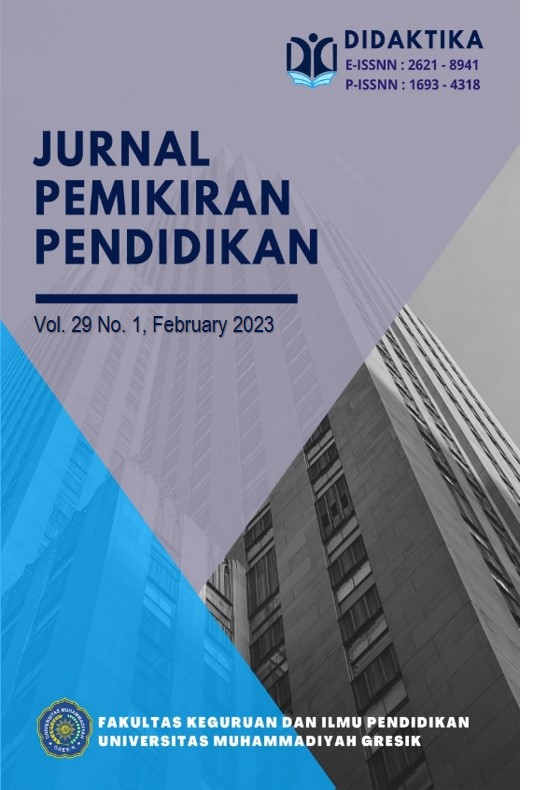Pengembangan E-modul Menggunakan Aplikasi Ispring Suite 10 dengan Penguatan Literasi Numerasi Pada Peserta Didik SMP
DOI:
https://doi.org/10.30587/didaktika.v29i1.5176Keywords:
Electronic Moduls, Ispring Suite 10, Numeracy LiteracyAbstract
This research was conducted to produce an e-module product that was given numeracy literacy reinforcement using the Ispring suite 10 application for class VIII students of SMP/MTs. This study obtained 2 criteria valid and effective, so it deserves to be used as a reference for learning companions for students. The method used in this development research refers to the 4D model which consists of define, design, development, and disseminate. This development test was carried out on a limited basis because there was no time limit. To measure the validity of the e-module instrument used in this development research is an expert validation sheet, while to measure the effectiveness of the e-module instrument used is a response questionnaire, test instrument and student activity observation sheet. The results obtained in this development research are 1) Valid criteria which can be seen through the percentage of validation results by material experts with a percentage of 96.92% with an evaluation test of 95.56%, and media experts with a percentage of 91.25%. 2) Effective criteria which can be seen from the percentage of student activity is 78.33%, the percentage of classical completeness is 78.57% and the percentage of student responses is 88.6%. Thus, the development of e-modules using the Ispring suite 10 application by strengthening numeracy literacy can be used as a student learning companion.
Downloads
Published
How to Cite
Issue
Section
License
License and Copyright Agreement
In submitting the manuscript to the journal, the authors certify that:
- They are authorized by their co-authors to enter into these arrangements.
- The work described has not been formally published before, except in the form of an abstract or as part of a published lecture, review, thesis, or overlay journal.
- That it is not under consideration for publication elsewhere,
- That its publication has been approved by all the author(s) and by the responsible authorities – tacitly or explicitly – of the institutes where the work has been carried out.
- They secure the right to reproduce any material that has already been published or copyrighted elsewhere.
- They agree to the following license and copyright agreement.
Copyright
Authors who publish with DIDAKTIKA: Jurnal Pemikiran Pendidikan agree to the following terms:
- Authors retain copyright and grant the journal right of first publication with the work simultaneously licensed under a Creative Commons Attribution License (CC BY-SA 4.0) that allows others to share the work with an acknowledgment of the work's authorship and initial publication in this journal.
- Authors are able to enter into separate, additional contractual arrangements for the non-exclusive distribution of the journal's published version of the work (e.g., post it to an institutional repository or publish it in a book), with an acknowledgment of its initial publication in this journal.
- Authors are permitted and encouraged to post their work online (e.g., in institutional repositories or on their website) prior to and during the submission process, as it can lead to productive exchanges, as well as earlier and greater citation of published work.
Licensing for Data Publication
Open Data and Software Publishing and Sharing
The journal strives to maximize the replicability of the research published in it. Authors are thus required to share all data, code or protocols underlying the research reported in their articles. Exceptions are permitted but have to be justified in a written public statement accompanying the article.
Datasets and software should be deposited and permanently archived inappropriate, trusted, general, or domain-specific repositories (please consult http://service.re3data.org and/or software repositories such as GitHub, GitLab, Bioinformatics.org, or equivalent). The associated persistent identifiers (e.g. DOI, or others) of the dataset(s) must be included in the data or software resources section of the article. Reference(s) to datasets and software should also be included in the reference list of the article with DOIs (where available). Where no domain-specific data repository exists, authors should deposit their datasets in a general repository such as ZENODO, Dryad, Dataverse, or others.
Small data may also be published as data files or packages supplementary to a research article, however, the authors should prefer in all cases a deposition in data repositories.











